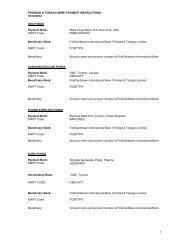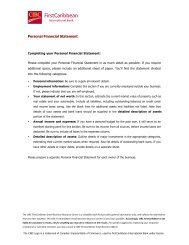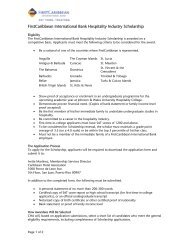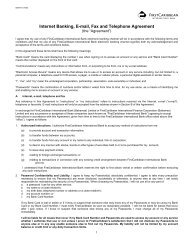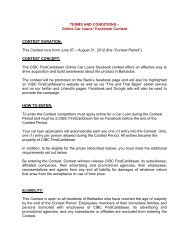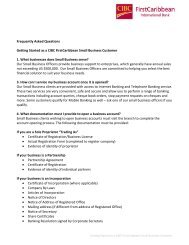(Jamaica) Limited - FirstCaribbean International Bank
(Jamaica) Limited - FirstCaribbean International Bank
(Jamaica) Limited - FirstCaribbean International Bank
Create successful ePaper yourself
Turn your PDF publications into a flip-book with our unique Google optimized e-Paper software.
notes to the Financial Statements<br />
Year Ended 31 October 2009<br />
(Expressed in <strong>Jamaica</strong>n dollars unless otherwise indicated)<br />
35. Financial Risk Management<br />
(a)<br />
Strategy in using financial instruments<br />
By its nature the Group’s activities are principally related to the use of financial instruments. The Group accepts<br />
deposits from customers at both fixed and floating rates and for various periods and seeks to earn above average<br />
interest margins by investing these funds in high quality assets. The Group seeks to increase these margins by<br />
consolidating short-term funds and lending for longer periods at higher rates whilst maintaining sufficient liquidity<br />
to meet all claims that might fall due.<br />
The Group also seeks to raise its interest margins by obtaining above average margins, net of provisions, through<br />
lending to commercial and retail borrowers with a range of credit standing. Such exposures involve not just onbalance<br />
sheet loans and advances but the Group also enters into guarantees and other commitments such as letters<br />
of credit and performance and other bonds.<br />
(b)<br />
Credit risk<br />
Credit risk primarily arises from direct lending activities, as well as from trading, investment and hedging activities.<br />
Credit risk is defined as the risk of financial loss due to a borrower or counter party failing to meet its obligations in<br />
accordance with agreed terms.<br />
Process and Control<br />
The Credit Risk Management Department (CRMD) is responsible for the provision of the Group’s adjudication,<br />
oversight and management of credit risk within its portfolios, including the measurement, monitoring and control<br />
of credit risk.<br />
The CRMD’s credit risk approval authority flows from the Board of Directors and are further delegated to the<br />
Chairman and the Chief Risk Officer (CRO). The department is guided by the Group’s Delegation of Authority<br />
Policy. Delegation is based on exposure and risk level; where the credit decision relates to larger and or higher risk<br />
transactions the Credit Committee (CC) is responsible for the final decision.<br />
The Risk and Conduct Review Committee (R&CRC) is responsible for approving policy requirements and key risk<br />
limits.<br />
Credit Risk Limits<br />
Credit limits are established for all loans (mortgages, personal and business & government) for the purposes<br />
of diversification and managing concentration. These include limits for individual borrowers, groups of related<br />
borrowers, industry sectors, and products or portfolios. The Group does not have excessive concentration in any<br />
single borrower, or related group of borrowers, or industry sector.<br />
Collateral<br />
The Group employs a range of policies and practices to mitigate credit risk. The most traditional of these is the taking<br />
of security for funds advanced, which is common practice. The Group implements guidelines on the acceptability<br />
of specific classes of collateral or credit risk mitigation. The principal collateral types for loans and advances to<br />
customers are:<br />
• Mortgages over residential properties;<br />
• Charges over business assets such as premises, inventory and accounts receivable;<br />
• Charges over financial instruments such as debt securities and equities.<br />
The Group’s credit risk management policies include requirements relating to collateral valuation and management,<br />
including verification requirements and legal certainty. Valuations are updated periodically depending upon the<br />
nature of the collateral. Management monitors the market value of collateral, requests additional collateral in<br />
accordance with the underlying agreement during its periodic review of loan accounts in arrears. Policies are<br />
in place to monitor the existence of undesirable concentration in the collateral supporting the Group’s credit<br />
exposure.<br />
68



